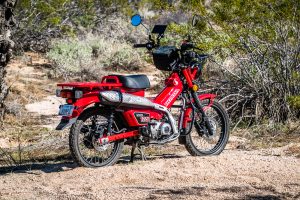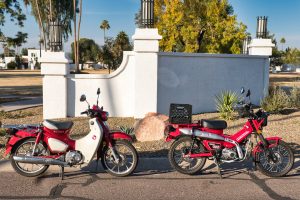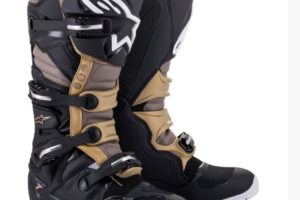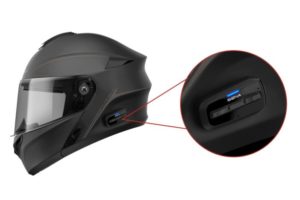I’ll say it right off the bat:Triumphknocked it out of the park withthis bike. Pretty much everything about it shows extreme attention to detail. Riding this bike is a joy and never a struggle. Lightweight and friendly, it’s a welcome addition to today’s middleweight motorcycle segment.
If you’re interested in first readingall the specs of the bikeor in apicture-laden walk-around, we have you covered there.

Cr照片edit: Kingdom Creative // Triumph
That Triple Engine
The 660 triple motor’s linear power delivery is directly on tap throughout the rev range. I did not expect a small engine to offer such tractable power. It’s not a machine that forces you to hunt for the power band; as long as you keep the revs over 2,000 rpm you’re in it. Roll on the throttle wherever you like, and the bike delivers.
The triple engine does not, however, offer very much engine braking. I am used to riding big twins, so I tend to keep engine revs on the low side. That is not the way to ride this bike. When one of the Triumph reps told me to “try to kill the engine,” I started keeping the revs way up (in the 7–8K range) and the bike absolutely came into its own. Don’t worry about buzziness; the engine does not complain about staying loaded up all the time. A really small amount of buzzing does come through the bars and the foot pegs, but it is not bothersome.
Triumph’s published fuel mileage is around 52 mpg, and a 4 1/2 gallon tank means you won’t be looking for gas very often. If there are four usable gallons in there you won’t start sweating until you’ve ridden 200 miles.
The throttle return spring is not heavy. I run a throttle rocker on my motorcycles at home to keep my tennis elbow from complaining on tour. Though I meant to bring one to fit to this test bike, I forgot—but I never missed it. Keeping the throttle open is never a struggle, and throttle response on this bike is close to mind-reading.
Handlebars
Speaking of those bars, they’re comfortable out of the box. They’re nice and wide which makes maneuvering the bike effortless, and they’re set high and back which means your back and shoulders never hurt from a too-far reach, even on an all-day ride.
Suspension and Chassis
The chassis remains settled through all kinds of input. The Showa USD fork and rear remote-adjustable shock handled everything I threw at them. There was never a moment when I felt as though the bike was unsettled. It absolutely ate bumpy roads through city traffic, wide sweepers, and quick back-and-forth twisty mountain roads. There was a moment when I was caught off-guard by a large, wide speed hump hidden in shadows; I didn’t prepare for it and was just along for the ride, but the bike remained composed even through my ham-fisted direction. It is also uniquely settled and easy to control at very low speeds. You won’t be tempted to send out the outriggers while parking; just swing a perfect U-turn, roll through a parking spot at slower than walking speed, feet on pegs and looking like a rock star. This bike will win you every slow race.

Cr照片edit: Kingdom Creative // Triumph
Brakes
The brakes are exactly what you want out of a bike this size. They deliver a progressive feel without being grabby, and if you find yourself overcooking a corner they dial the bike back quickly and efficiently. I was never surprised by too much brake, and never wanted or needed more than it had on tap. The ABS is obvious but unobtrusive.
Transmission and Clutch
The Tiger Sport 660’s transmission is invisible. Smooth shifts and positive feedback are the name of the game. I never missed a shift all day, even when I once only grazed the shifter peg with my boot. I let the clutch out and the bike was in the gear I was aiming for, as if the bike knew what I wanted, and took my unsteady command to heart.
The clutch pull is just a touch on the heavy side, but if you’re riding the bike correctly, you do not need to shift very much, and that pull won’t cramp you. There’s never a moment of hunting for the power band. Keep the revs up and it’s perfectly happy to strafe mountain roads in third gear all day long. That said, Triumph can fit a quickshifter as an accessory upgrade.
Seating and Ergonomics
The stock seat, while its published height is nearly 33 inches, is quite narrow near the tank for a great “stand-over” height. It’s soft but not too soft; for a stock seat it is surprisingly comfortable. Those of us who replace a new motorcycle’s stock seat as a matter of course could probably delay that purchase on this bike. Triumph offers a “comfort” seat as well as a low seat for the bike for folks who are a bit more vertically challenged. Despite its looks, the seating position is very neutral, does not push a rider forward into the tank, and is surprisingly roomy. I was able to “hump the tank,” so to speak, in the twisties but also sit much farther back on the seat when I needed a change in position.
The peg-to-seat distance is ADV-bike comfortable. At six feet tall and with a 36-inch inseam, I never felt cramped up on the bike. My knees never complained.
Tires
Triumph fitted Michelin Road 5 tires on the cast wheels and, while the “Pilot Road” and now “Road” line of Michelins have long been my personal sport-touring favorites, others were also remarking about the great grip, predictable turn-in, and great edge-to-edge performance, so it’s not just my personal preferences talking.
Lighting
The LED headlights create a very distinctive “face” that makes the oncoming bike highly visible. LED signals are nice and bright without being ugly or obtrusive. The contoured, heart-shaped LED taillight, however, could use just a hint more development. More than once, if I was looking through a turn instead of at the next Tiger 660 in front of me, I couldn’t tell if the rider was on the brakes or not (until the lights dimmed a touch when they let go of the brake).
Switchgear and Cockpit
骑手会发现所有的胜利switchgear exactly where it should be, every time, except for the high-beam switch. If you’re not used to riding Triumphs, you might need to hunt: it’s mounted on the front of the left grip and perfectly hidden while you’re in the seat. Once you’re used to that placement it makes perfect sense. The self-cancelling turn signals took a bit of getting used to (tap for three flashes, really push to keep them on longer), but worked just like I wanted them to, once I figured them out.
An extremely easy-to-navigate combination LCD/TFT screen up front delivers all the information you want, makes switching ride modes very straightforward, and is very readable even in bright sunlight at a quick glance. I didn’t get to test out the MyTriumph app, but I have confidence that the design is as intuitive as everything else about the bike.
Windshield
Wind protection comes from a one-handed operation up front. Grab the handle just over the bike’s dash and yank, and the screen comes up (with a bit of resistance). There are definite stops along its travel so you can tune the ride height to your preference: it’s not just all the way up, or all the way down. Since everyone is different, and I’m pretty short in the torso, the highest windshield position created just a touch of buffeting at the top of my helmet. It wasn’t too noisy or bothersome; indeed, I kept it there for the rest of the day.
Heat Management
I will say this: having test-ridden the last generation of Triumph Tiger 1200, I was worried about heat management. The 1200 I rode (perhaps it was a one-off problem?) absolutely roasted me in the saddle on a beautiful, moderately cool day. I loved that bike but the heat it tossed on me made it unrideable. The liquid-cooled 660 suffers no such problems. Our ride temperatures hovered around 65°F but heat came off the engine only occasionally, and then, around my knee and upper calf. Of all the motorcycles I’ve ever ridden, the Sport 660 rates among the coolest to ride—literally.

Cr照片edit: Kingdom Creative // Triumph
Cost of Ownership
There is a lot of chatter about low cost of ownership and long maintenance intervals from the manufacturer. As I’ve stated,repair and maintenance is a big deal, especially for riders who don’t or can’t do it themselves. Triumph specs a 10,000 mile interval for motor oil and air filter changes, and a 20,000 mile interval for valve clearance checks, spark plug replacement, and rear suspension linkage lubrication. The bike comes with a 2-year, unlimited mile warranty.
Fit and Finish
Triumph excelled at the bike’s fit and finish. The Tiger sits and rides like a much more expensive bike. I noticed so many little touches that showed the bike’s designers put a ton of thought into all the little corners of this bike. From the super-tidy cockpit to the rear grab handles, the whole bike has the quality of a well-made tool: feels good in your hand and makes you want to touch it. There are no sharp corners or obvious mold lines.
The Sum of its Parts
The personality of this bike is that of a friendly, unobtrusive, well-trained dog. It isn’t an over-eager puppy, but feels built to be your best friend, to take care of you on the ride, and at every turn, no matter what you ask of it, it says “I got you.” It never does anything you do not ask it to do. That said, and I might get a bit woo-woo here, I found it was just not much of a conversationalist, if you get me. Some bikes talk to you constantly, to tell you exactly what they do and do not like. Perhaps that’s “character.” This bike is extremely obedient at all speeds, never complains, but also doesn’t whisper sweet nothings, or challenge you to do something you really, really shouldn’t. It simply delivers quiet confidence.
我的印象
All told, the Tiger Sport 660 is an impressive, capable, composed, extremely friendly bike. It will tackle traffic and the track, mountain roads and poorly paved surfaces. It will handle dirt roads as well as any street bike; probably better. One question kept bubbling up, though: Who is this bike for?
Marketing it as an ADV bike is probably as close to the correct segment as possible, since nobody calls anything a “standard” anymore. Its lack of offroad chops, though, is going to be forum bait. And it’s too leggy to be a true sport bike.
I sincerely hope that Triumph can put the motorcycle in front of the correct audience, because it is an incredible package at an extremely competitive price. But who is the correct audience?
Who Wants This Bike?
- Aging sportbike enthusiasts. Those riders who cut their teeth on the old CBR F2/3/4s, or GSXRs, or the larger Ninjas. Those riders who enjoy really wringing a bike’s neck, but just can’t handle the sporty seating position anymore, or maybe want some luggage options and better wind protection.
- Folks who are tired of, or leery of, heavy sport tourers, but who still want to sport-tour.
- Anyone who bought a very dirt-biased ADV bike and are realizing their mistake: that their daily riding doesn’t take them off road.
- People who want a sport bike, but live in the snow belt and need something that can handle pothole-filled corners like a sportbike can’t.
- Riders who only have room for one motorcycle: this is an all-rounder. It will be your commuter, your weekend mountain-road eater, your track bike, your campground carrier and occasional dirt-road tackler, and your cross-country tourer all in one.
- Newer riders, who are ready to move on to a bike that’s comfortable and travel-worthy, and who don’t want something enormous.
If Triumph can get this motorcycle on enough people’s lists of potentials they are going to win this game. The trick is, will it pop up in enough searches?







